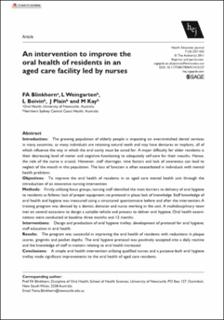| dc.contributor.author | Blinkhorn, F.A. | |
| dc.contributor.author | Weingarten, L. | |
| dc.contributor.author | Boivin, L. | |
| dc.contributor.author | Plain, J. | |
| dc.contributor.author | Kay, M. | |
| dc.date.accessioned | 2020-06-10T12:58:42Z | |
| dc.date.available | 2020-06-10T12:58:42Z | |
| dc.date.issued | 2011 | |
| dc.identifier.citation | Blinkhorn, F., Weingarten, I., Boivin, L., Plain, J. & Kay, M. (2012). An intervention to improve the oral health of residents in an aged care facility led by nurses. Health Education, 71(4), 527 - 535. | en_US |
| dc.identifier.uri | https://hdl.handle.net/11250/2657589 | |
| dc.description.abstract | Introduction: The growing population of elderly people is impacting on overstretched dental services in many countries, as many individuals are retaining natural teeth and may have dentures or implants, all of which influence the way in which the oral cavity must be cared for. A major difficulty for older residents is their decreasing level of motor and cognitive functioning to adequately self-care for their mouths. Hence, the role of the nurse is crucial. However, staff shortages, time factors and lack of awareness can lead to neglect of the mouth in this population. The loss of function is often exacerbated in individuals with mental health problems.
Objectives: To improve the oral health of residents in an aged care mental health unit through the introduction of an innovative nursing intervention.
Methods: Firstly, utilizing focus groups, nursing staff identified the main barriers to delivery of oral hygiene to residents as follows: lack of proper equipment; no protocol in place; lack of knowledge. Staff knowledge of oral health and hygiene was measured using a structured questionnaire before and after the intervention. A training program was devised by a dentist, dietician and nurse working in the unit. A multidisciplinary team met on several occasions to design a suitable vehicle and process to deliver oral hygiene. Oral health examinations were conducted at baseline, three months and 12 months.
Interventions: Design and production of oral hygiene trolley; development of protocol for oral hygiene; staff education in oral health.
Results: The program was successful in improving the oral health of residents with reductions in plaque scores, gingivitis and pocket depths. The oral hygiene protocol was positively accepted into a daily routine and the knowledge of staff in matters relating to oral health increased.
Conclusions: A simple oral health intervention utilizing qualified nurses and a purpose-built oral hygiene trolley made significant improvements to the oral health of aged care residents. | en_US |
| dc.publisher | Health Education Journal | en_US |
| dc.subject | aged care | en_US |
| dc.subject | nurses | en_US |
| dc.subject | oral health | en_US |
| dc.subject | prevention | en_US |
| dc.title | An intervention to improve the oral health of residents in an aged care facility led by nurses | en_US |
| dc.type | Journal article | en_US |
| dc.source.pagenumber | 527-535 | en_US |
| dc.source.volume | 71 | en_US |
| dc.source.journal | Health Education Journal | en_US |
| dc.source.issue | 4 | en_US |
| dc.identifier.doi | https://doi.org/10.1177%2F0017896911412127 | |
| dc.description.localcode | måsjekkes | |
